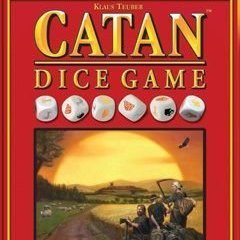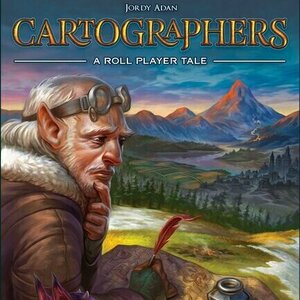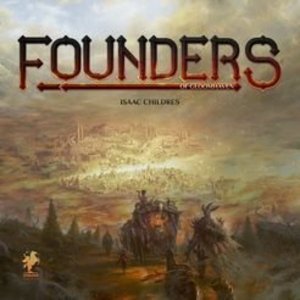Search
Search results

Catan: The dice game
Tabletop Game
Like all the other games of the "Settlers of Catan" series, this game is about building settlements,...
BoardGames CatanGames RollnWriteGames
Purple Phoenix Games (2266 KP) rated Dragons Wild in Tabletop Games
Feb 1, 2021
Have you ever had Gamer Deja Vu? Like you know you’ve played this game before but don’t remember, or the mechanics just feel so familiar? I have it seldomly, but I still feel it at times. What I enjoy about certain games is how quick they are teach, have familiar mechanics, but also have their own twists to truly make it unique. Have I found that here with Dragons Wild?
Dragons Wild is a trick-taking game very similar to the old standard, Rummy. So like its predecessor players are trying to rid their hands of cards in order to signal the end of the game. Where this version separates is in the little details that are absent from Rummy.
DISCLAIMER: We were provided a prototype copy of this game for the purposes of this review. These are preview copy components, and I do not know for sure if the final components will be any different from these shown. Also, it is not my intention to detail every rule in the game, as there are just too many. You are invited to download the rulebook, back the game through the Kickstarter campaign launching February 2, 2021, or through any retailers stocking it after fulfillment. -T
To setup choose a dealer and a scorer (different players). The dealer will shuffle the entire deck of cards, save for the scoring cards, and deal each player seven cards. The draw deck is placed in the middle of the table and the dealer flips the top card to create the discard pile. The scorer finds the reference score card and places the dragon token on or near the “Round 1, Score 8 per card” text. The game may now begin!
Generally, the game is played much like Rummy where players are attempting to lay down melds of cards containing either runs (1, 2, 3, 4, etc) or sets (2, 2, 2 of different suits). Once a player has a meld in front of themselves they may play their cards onto other players’ melds. Players must discard a card at the end of each turn, and play continues in this manner until a player runs out of cards.
Dragons Wild, however, adds a few twists to pump up the play of traditional Rummy. Each player will need to keep track of their point totals as they will change with each play of a card. Should a player lay a meld on Round 1 they score eight VP for each card laid. In Round 2 cards are worth seven points each. Round 3 each card is worth six points and so on until Round 8 (or more) where each card is worth just one point.
Another way in which Dragons Wild differs from its older cousin is in the buying of cards (as far as I remember – I’m no Rummy expert). On their turn the active player must draw a card from either the top of the draw deck or the top of the discard pile. However, before the active player chooses, should another player wish to buy the face-up discard card the active player decides to allow or disallow the buy. With a successful buy the buying player takes the discarded card as well as the top card of the draw deck as payment. A player may buy as many as three cards in this fashion for each new active player.
Also, Dragons Wild offers a slight rule change for Wild cards in melds. Every time I have played Rummy in my lifetime any Wild is up for grabs as long as it can be replaced with a legal card from any player’s hand on their turn. This is not the case in Dragons Wild, as only Wild cards that hang on the end of a RUN of cards may be taken, replaced, or moved to the other end by the active player.
The game ends once one player is able to rid their entire hand of cards and still have one card to discard at the end of their turn. Players then total their scores from all cards played, scoring points differently depending on the Round in which they were laid. Other players still possessing cards then subtract the NUMBER of cards still held from their entire score, not their values. The player with the most points after this scoring phase is the winner!
Components. Again, this is a prototype copy of the game, and I am completely unsure which, if any, components will be upgraded as a result of a successful Kickstarter campaign. That said, I can comment on a couple things. First, the art style. While it is not my cup of tea (dragons have tea parties, right?) I can see where others may quite enjoy its fancifulness and whimsy. The game is very colorful, and I do appreciate that quite a lot. The cards are laid out well, and each suit is a different species of fantastic beast (though I rarely knew which was which – I just paid attention to the background color in the corners of the cards mostly). So I have no real problems with the components at all, I just wish for different art. The designer was nice enough to send along a print of a purple phoenix with this copy, which is super rad of her, and it looks great. Maybe she will add them into the final version…
Gameplay is familiar, like I stated earlier, because I would think most people have played Rummy or a variation of it at some point. In fact, my family was big into Rummikub growing up, and my grandparents were big into Rummy proper. So this was somewhat nostalgic for me while also bringing a few house rules and art that is different from a boring deck of normal playing cards.
The rules are not at all difficult, so learning, teaching, and playing have not seemed to be an issue at all here. If players have all played a version of Rummy before then this one will fly pretty quickly. It is a simple, fast, and slightly unique version of Rummy that would be nice to keep around if you need to wait on another player to arrive and they are 10 minutes away, or as a palette cleanser between games. Definitely a filler game, and not at all a bad one!
If you are looking for a differently-themed Rummy replacement with a twist, I recommend checking out Dragons Wild. It’s cute, quick, and has dragons, for Pete’s sake. Consider backing the Kickstarter campaign or asking your LFGS to stock it upon release.
Dragons Wild is a trick-taking game very similar to the old standard, Rummy. So like its predecessor players are trying to rid their hands of cards in order to signal the end of the game. Where this version separates is in the little details that are absent from Rummy.
DISCLAIMER: We were provided a prototype copy of this game for the purposes of this review. These are preview copy components, and I do not know for sure if the final components will be any different from these shown. Also, it is not my intention to detail every rule in the game, as there are just too many. You are invited to download the rulebook, back the game through the Kickstarter campaign launching February 2, 2021, or through any retailers stocking it after fulfillment. -T
To setup choose a dealer and a scorer (different players). The dealer will shuffle the entire deck of cards, save for the scoring cards, and deal each player seven cards. The draw deck is placed in the middle of the table and the dealer flips the top card to create the discard pile. The scorer finds the reference score card and places the dragon token on or near the “Round 1, Score 8 per card” text. The game may now begin!
Generally, the game is played much like Rummy where players are attempting to lay down melds of cards containing either runs (1, 2, 3, 4, etc) or sets (2, 2, 2 of different suits). Once a player has a meld in front of themselves they may play their cards onto other players’ melds. Players must discard a card at the end of each turn, and play continues in this manner until a player runs out of cards.
Dragons Wild, however, adds a few twists to pump up the play of traditional Rummy. Each player will need to keep track of their point totals as they will change with each play of a card. Should a player lay a meld on Round 1 they score eight VP for each card laid. In Round 2 cards are worth seven points each. Round 3 each card is worth six points and so on until Round 8 (or more) where each card is worth just one point.
Another way in which Dragons Wild differs from its older cousin is in the buying of cards (as far as I remember – I’m no Rummy expert). On their turn the active player must draw a card from either the top of the draw deck or the top of the discard pile. However, before the active player chooses, should another player wish to buy the face-up discard card the active player decides to allow or disallow the buy. With a successful buy the buying player takes the discarded card as well as the top card of the draw deck as payment. A player may buy as many as three cards in this fashion for each new active player.
Also, Dragons Wild offers a slight rule change for Wild cards in melds. Every time I have played Rummy in my lifetime any Wild is up for grabs as long as it can be replaced with a legal card from any player’s hand on their turn. This is not the case in Dragons Wild, as only Wild cards that hang on the end of a RUN of cards may be taken, replaced, or moved to the other end by the active player.
The game ends once one player is able to rid their entire hand of cards and still have one card to discard at the end of their turn. Players then total their scores from all cards played, scoring points differently depending on the Round in which they were laid. Other players still possessing cards then subtract the NUMBER of cards still held from their entire score, not their values. The player with the most points after this scoring phase is the winner!
Components. Again, this is a prototype copy of the game, and I am completely unsure which, if any, components will be upgraded as a result of a successful Kickstarter campaign. That said, I can comment on a couple things. First, the art style. While it is not my cup of tea (dragons have tea parties, right?) I can see where others may quite enjoy its fancifulness and whimsy. The game is very colorful, and I do appreciate that quite a lot. The cards are laid out well, and each suit is a different species of fantastic beast (though I rarely knew which was which – I just paid attention to the background color in the corners of the cards mostly). So I have no real problems with the components at all, I just wish for different art. The designer was nice enough to send along a print of a purple phoenix with this copy, which is super rad of her, and it looks great. Maybe she will add them into the final version…
Gameplay is familiar, like I stated earlier, because I would think most people have played Rummy or a variation of it at some point. In fact, my family was big into Rummikub growing up, and my grandparents were big into Rummy proper. So this was somewhat nostalgic for me while also bringing a few house rules and art that is different from a boring deck of normal playing cards.
The rules are not at all difficult, so learning, teaching, and playing have not seemed to be an issue at all here. If players have all played a version of Rummy before then this one will fly pretty quickly. It is a simple, fast, and slightly unique version of Rummy that would be nice to keep around if you need to wait on another player to arrive and they are 10 minutes away, or as a palette cleanser between games. Definitely a filler game, and not at all a bad one!
If you are looking for a differently-themed Rummy replacement with a twist, I recommend checking out Dragons Wild. It’s cute, quick, and has dragons, for Pete’s sake. Consider backing the Kickstarter campaign or asking your LFGS to stock it upon release.
Purple Phoenix Games (2266 KP) rated Cartographers: A Roll Player Tale in Tabletop Games
Sep 13, 2021
I have often wondered how cartography actually works. How was it that people with primitive tools were able to grasp the lay of the land and sea? And are we complete in our mapping of Earth or are there more secrets we have yet to discover? Thankfully, in Cartographers we aren’t really answering those questions, but other practical questions may arise.
Cartographers is a flip-and-write style game where players are competing to gain the queen’s favor and become the royal cartographer. While the main game focuses on finishing with a greater score than your opponent(s) the solo game is more relaxed. The solo player will be competing against their previous scores and comparing against the queen’s title matrix. Each game will be played over four seasons (rounds) and once the year is over the winner or title is claimed. Can you score 30 or more points to become a “Legendary Cartographer?”
To setup, lay out the Queen’s Edict cards that show A, B, C, and D. Shuffle each small deck of like-backed Scoring Cards and randomly place one from each deck underneath the Edict cards. Remove all the enemy Ambush Cards and shuffle one into the main deck of Explore Cards. Set the Season Cards in order: Spring, Summer, Fall, and Winter. Each player will receive one Map Sheet and a pencil. The game may now begin!
Each Season Card will feature a time threshold number that when met or exceeded will end the season. This corresponds to the time markings on each Explore Card drawn from the deck. For example, Spring allows 8 measures of time before it will switch to Summer. Explore Cards will usually show from 0-2 time measures on it, so seasons could change after four or more cards. At the start of each season, the player will flip an Explore Card to reveal which type of map element is requested and of which shape. The map elements are Forest, Farm, Water, Village, Mountain, and Monster. The shapes shown on the cards are reminiscent of Tetris-style shapes and also some others as well.
Once a card has been revealed, the player now will draw on their sheet the shape (or one of the shapes if more than one are shown) and fill it in with the matching symbol for map element type. If during this phase of the round the player surrounds the four sides of a pre-printed Mountain square they will score one coin and mark it at the bottom of their Map Sheet.
Should a Ruins card be revealed the player will flip another card to reveal the next card in line. Whatever shape and element is shown on the card AFTER the Ruins card will be used, with a twist. The shape shown on this card will now be required to encompass one of the pre-printed Ruins squares on the Map Sheet. If there are no legal spaces to place these shapes (or any shape on future cards) the player will be allowed to place a single 1×1 square on their Map Sheet anywhere they wish.
Should an enemy Ambush card be revealed the player will check which corner of the map the ambush takes place and will draw the provided monster shape in the closest area to the corner as possible. These are awarded negative points at the end of the seasons and can make large impacts on final scores.
After the elements have been drawn on the Map Sheet the player will check if the season ends. The season will end if the total number of revealed cards’ time measures equal or exceed the time printed on the Season Card (again, for example, Spring lasts 8 time). If not, then the player resumes another card reveal. If the time threshold has been met or exceeded then the player will score for the season by referencing the Scoring Cards that were placed under the Edicts at setup. For Spring the player scores Edict Cards A and B. Mark the score in the space provided at the bottom of the Scoring Sheet and flip the Season Card to the next season to begin a new round.
Play continues in this fashion until all four seasons have been played. At the end of the fourth season the game ends and the player will tally up their score to compare against the queen’s title matrix at the back of the rulebook. Not to brag, but my first game scored over 30 points, so I began this journey as a Legendary Cartographer.
Components. This game is 100 double-sided Map Sheets, four golf pencils, and a bunch of cards. The sheets and pencils are just fine, and the cards are good quality. What I really enjoy about the components is that this is “A Roll Player Tale,” meaning that many of the components and art hearken back to the original Roll Player game. As I love Roll Player’s art style, I also love that of Cartographers. There isn’t a ton of art in the game, more of graphic design, the art that IS provided is stellar Roll Player fare. I have no complaints about the components here except my wife thinks the pencil erasers could be better.
I skipped backing this one on Kickstarter and have only recently come to acquire it. I am definitely kicking myself in the rear for that decision because this is an excellent game. Obviously, anything that is enjoyable solo AND multiplayer is a huge boon (my wife scored it a 5!), and being able to play it multiple times in a row is a benefit as well.
We both love the decision-making in Cartographers, and when we first played together I had to shield my map sheet from my wife because she was copying! SHE was copying ME! She ended up handing me my booty in that game (of course) but we both had a great time plotting out our map elements. Determining where and which direction a shape should be placed can certainly be frustrating, but seeing your well-laid plans come to life is very rewarding. I am definitely seeing myself needing to download and print off more map sheets in the future because I have a feeling I am going to be playing the mess out of this one.
If you are looking for something special for your collection, check out Cartographers. If you already enjoy Roll Player, this will feel homey to you while offering a completely different style of game. My wife and I love it, and I am not sure I know anyone who would turn their nose up at it. Once we get into the Post-COVID era I plan to play this all the time at game nights.
Cartographers is a flip-and-write style game where players are competing to gain the queen’s favor and become the royal cartographer. While the main game focuses on finishing with a greater score than your opponent(s) the solo game is more relaxed. The solo player will be competing against their previous scores and comparing against the queen’s title matrix. Each game will be played over four seasons (rounds) and once the year is over the winner or title is claimed. Can you score 30 or more points to become a “Legendary Cartographer?”
To setup, lay out the Queen’s Edict cards that show A, B, C, and D. Shuffle each small deck of like-backed Scoring Cards and randomly place one from each deck underneath the Edict cards. Remove all the enemy Ambush Cards and shuffle one into the main deck of Explore Cards. Set the Season Cards in order: Spring, Summer, Fall, and Winter. Each player will receive one Map Sheet and a pencil. The game may now begin!
Each Season Card will feature a time threshold number that when met or exceeded will end the season. This corresponds to the time markings on each Explore Card drawn from the deck. For example, Spring allows 8 measures of time before it will switch to Summer. Explore Cards will usually show from 0-2 time measures on it, so seasons could change after four or more cards. At the start of each season, the player will flip an Explore Card to reveal which type of map element is requested and of which shape. The map elements are Forest, Farm, Water, Village, Mountain, and Monster. The shapes shown on the cards are reminiscent of Tetris-style shapes and also some others as well.
Once a card has been revealed, the player now will draw on their sheet the shape (or one of the shapes if more than one are shown) and fill it in with the matching symbol for map element type. If during this phase of the round the player surrounds the four sides of a pre-printed Mountain square they will score one coin and mark it at the bottom of their Map Sheet.
Should a Ruins card be revealed the player will flip another card to reveal the next card in line. Whatever shape and element is shown on the card AFTER the Ruins card will be used, with a twist. The shape shown on this card will now be required to encompass one of the pre-printed Ruins squares on the Map Sheet. If there are no legal spaces to place these shapes (or any shape on future cards) the player will be allowed to place a single 1×1 square on their Map Sheet anywhere they wish.
Should an enemy Ambush card be revealed the player will check which corner of the map the ambush takes place and will draw the provided monster shape in the closest area to the corner as possible. These are awarded negative points at the end of the seasons and can make large impacts on final scores.
After the elements have been drawn on the Map Sheet the player will check if the season ends. The season will end if the total number of revealed cards’ time measures equal or exceed the time printed on the Season Card (again, for example, Spring lasts 8 time). If not, then the player resumes another card reveal. If the time threshold has been met or exceeded then the player will score for the season by referencing the Scoring Cards that were placed under the Edicts at setup. For Spring the player scores Edict Cards A and B. Mark the score in the space provided at the bottom of the Scoring Sheet and flip the Season Card to the next season to begin a new round.
Play continues in this fashion until all four seasons have been played. At the end of the fourth season the game ends and the player will tally up their score to compare against the queen’s title matrix at the back of the rulebook. Not to brag, but my first game scored over 30 points, so I began this journey as a Legendary Cartographer.
Components. This game is 100 double-sided Map Sheets, four golf pencils, and a bunch of cards. The sheets and pencils are just fine, and the cards are good quality. What I really enjoy about the components is that this is “A Roll Player Tale,” meaning that many of the components and art hearken back to the original Roll Player game. As I love Roll Player’s art style, I also love that of Cartographers. There isn’t a ton of art in the game, more of graphic design, the art that IS provided is stellar Roll Player fare. I have no complaints about the components here except my wife thinks the pencil erasers could be better.
I skipped backing this one on Kickstarter and have only recently come to acquire it. I am definitely kicking myself in the rear for that decision because this is an excellent game. Obviously, anything that is enjoyable solo AND multiplayer is a huge boon (my wife scored it a 5!), and being able to play it multiple times in a row is a benefit as well.
We both love the decision-making in Cartographers, and when we first played together I had to shield my map sheet from my wife because she was copying! SHE was copying ME! She ended up handing me my booty in that game (of course) but we both had a great time plotting out our map elements. Determining where and which direction a shape should be placed can certainly be frustrating, but seeing your well-laid plans come to life is very rewarding. I am definitely seeing myself needing to download and print off more map sheets in the future because I have a feeling I am going to be playing the mess out of this one.
If you are looking for something special for your collection, check out Cartographers. If you already enjoy Roll Player, this will feel homey to you while offering a completely different style of game. My wife and I love it, and I am not sure I know anyone who would turn their nose up at it. Once we get into the Post-COVID era I plan to play this all the time at game nights.
Jason James (3 KP) rated Founders of Gloomhaven in Tabletop Games
Apr 4, 2019
Founders of Gloomhaven is a 1 to 4 player cooperative/competitive game. In short, players must work to build the city of Gloomhaven. The game provides a two-sided board and depending on which side you choose it slightly changes how the game is played. All players choose a character race and any additional resource cards. This determines which resources the players will automatically own during the game. However, other players will have the opportunity to buy access to resources they do not own. This is vital when building "upgraded" buildings. Each player starts with the same five cards (six cards in a two-player game). Players will have a chance to acquire new card by recruiting advisers, which are upgraded versions of the base cards. Play begins with a player laying down a card they wish to play. They follow the instructions on the top of the card, and then each other player will have a chance to follow the instructions laid out on the bottom of the card. Card actions can always be switched out with a set of basic actions (collect one gold or influence, build a road, or place a worker). If a player chooses (or is forced) to play a "Call to Vote" card, they collect one gold or influence, or build one road for each of the remaining cards in their hand. They reset all of their workers and collect their discard pile. All other players have a chance to collect gold based on the number of resources they own. Then all players vote for which prestige building they want to be built. All players reveal their choice token along with any influence they wish to spend. The player with the most votes gets to place the building anywhere on the map. Points are scored by connecting upgraded buildings to resources you own but is slightly more difficult with the games unique "trickle down" scoring system. This means that some points may have to be shared with players who own base the resources or other upgraded building needed to build the building that was just placed.
Overall this game is for people who enjoy other similar games like Catan or Ticket to Ride. Players must adjust to the fact that roads are public tiles that can connect any players resources to buildings. The game is high statistical and players must be able to make decisions that may result in other players gaining points. I would give the game an 8/10 as it brings a fresh feel to city-building board games! If you have any questions or have any comments on my review please feel free to message me.
Thanks!
Overall this game is for people who enjoy other similar games like Catan or Ticket to Ride. Players must adjust to the fact that roads are public tiles that can connect any players resources to buildings. The game is high statistical and players must be able to make decisions that may result in other players gaining points. I would give the game an 8/10 as it brings a fresh feel to city-building board games! If you have any questions or have any comments on my review please feel free to message me.
Thanks!

Coach it Soccer
Sports and Productivity
App
Built exclusively for the iPad, Coach it Soccer is the first application of its kind, to help soccer...



